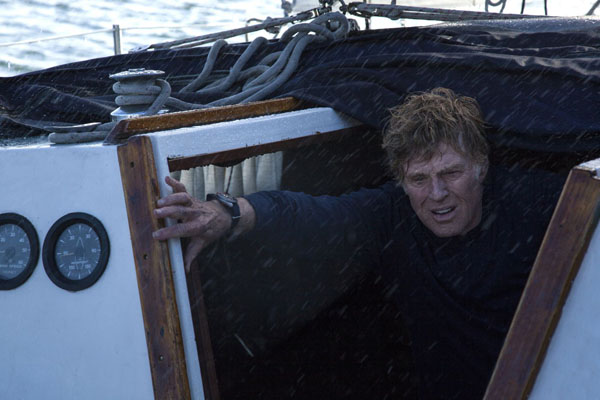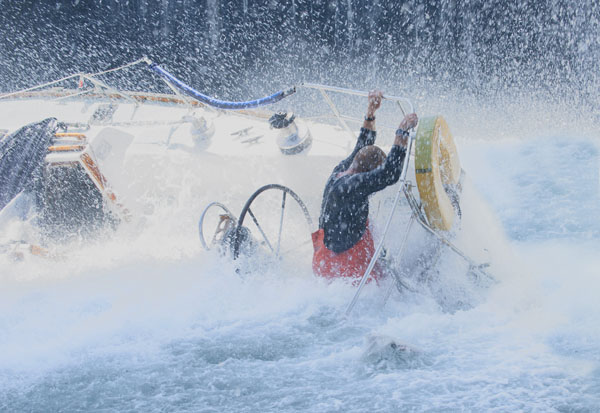We begin with EW‘s Owen Gleiberman: “All Is Lost is a man-stranded-at-sea movie, starring Robert Redford, in a role that has almost no dialogue, as a fellow who wakes up in his small yacht, somewhere in the middle of the Indian Ocean, only to discover that a random floating railway car—who knows how it got there?—has gashed a hole in the boat’s hull. It’s like his own miniature iceberg scrape: All of a sudden, his boat could go down, and him with it. Most movies that strand a solitary figure at sea, like Life of Pi, or on a desert island, like Cast Away or the template of the whole genre, Robinson Crusoe, are lonely but upbeat tales of invention and survival. J.C. Chandor, the writer and director of All Is Lost, does a radical existential twist on those tales.”
“Chandor decisively [avoids] the sophomore slump with a picture that could scarcely be more different from his 2011 debut, Margin Call,” writes Variety‘s Justin Chang. “With no background or exposition, viewer identification is thus reduced to the simplest, most primal level of wondering whether Redford’s character will survive, and it’s a measure of how carefully the film avoids the usual dramatic expedients and manipulations that the answer to that question is never entirely obvious.”
“Margin Call showed off Chandor’s talent for snappy dialogue, but here he succeeds in paring the struggle to its purely visual essence, allowing Redford the freedom to literally let action define character,” writes Mike D’Angelo at the AV Club. “It’s hard to say if this is a great performance—arguably, it’s too single-minded to achieve greatness—but it’s precisely what the movie requires, and Redford commits himself wholeheartedly to the Mamet-approved technique of performing each necessary action as simply and directly as possible…. [T]his is a uniquely thrilling stunt, as well as proof that most backstory is unnecessary bullshit. May Hollywood take note.”
“On one level this pared-down strategy makes for a beautifully simple idea,” finds the Guardian‘s Andrew Pulver: “we are presented with the human as animal, scrapping with the fish and sharks (occasionally seen, creepily, circling under Redford’s craft). But it also makes forcefully clear the advantages of the conventions of character fleshing-out: we are never allowed inside Redford’s mind, and the character remains almost entirely opaque.”
“Virtually each shot is a reminder, decades since Redford appeared onscreen in a truly challenging role, that he’s one of America’s great actors,” argues Indiewire‘s Eric Kohn.
“Chandor certainly set a major technical challenge for himself here,” writes the Hollywood Reporter‘s Todd McCarthy, “and he carries it off well… The general feel is one of creative resourcefulness and intelligent industry rather than radical experimentalism or creative cliff-diving.”
“Chandor and his cinematographer Frank G. DeMarco (as well as his underwater director of photography Peter Zuccarini) give All Is Lost a gorgeous look without allowing the character’s struggle to turn picturesque,” adds Tim Grierson in Screen. “Chandor’s shot selection avoids showiness, but editor Pete Beaudreau cuts around just enough so that the film never becomes too static.”
All Is Lost “has such rhythm and intensity that it makes utterly compelling viewing,” writes Geoffrey Macnab in the Independent. HitFix‘s Gregory Ellwood notes that Lionsgate and Roadside Attractions will release All Is Lost in the US on October 25.
Updates, 5/23: “For all the screen time he has spent gazing meaningfully into the receptive eyes of Natalie Wood, Jane Fonda, Barbra Streisand, Faye Dunaway, Meryl Streep and, first and finest, Paul Newman, Redford always projected a curious self-sufficiency,” writes Mary Corliss for Time. “The characters he has played seemed to enjoy people’s company but not to need it. He embraced solitude on the slopes (Downhill Racer), in the mountains (Jeremiah Johnson) or on a ranch (The Horse Whisperer). Even in a crowd he could be alone; the political advisors in The Candidate, the ballplayers in The Natural, were white noise that barely penetrated the cocoon of his mystery. The California blond with the calculating brain was a separate species, independent of and perhaps impatient with the mass of mortals. In the harshest elements, he could survive on his own…. Redford here battles the elements and mortality with a thinking man’s resilience. That makes All Is Lost a signal film achievement and the capstone to a great star’s career. This is Ultimate Redford.”
Adds the Telegraph‘s Robbie Collin: “Face wind-bronzed, hands rope-calloused, hair salt-thickened, Redford is a wonder in the role; come the winter, he may prove to be highly awards-toutable too.”
“In some ways,” suggests Ben Kenigsberg at RogerEbert.com, “All Is Lost plays like a mass-audience counterpart to Lucien Castaing-Taylor and Véréna Paravel’s great fishing-trawler doc Leviathan (shown at last year’s festivals and opening soon). Both films look to the ocean to expand conventional notions of what cinema can do.”
“From bow to stern, Chandor delivers pure cinema,” writes Jordan Hoffman at Film.com.
Updates, 5/24: “Why is All Is Lost being shown in special, Hors Competition (out of competition) screenings, ineligible for the Palme d’Or?” asks Jada Yuan at Vulture. “Several people who’ve talked to producers say Cannes programmers declared the two-hour, practically wordless, single-actor nautical adventure ‘too commercial’ to compete. (This from a festival that had Lawless and On the Road in competition last year.) My guess is that there were other politics at play. There’s only one person in this movie, and he happens to be the founder of America’s premier film festival (Sundance), and it’s not fair to put a jury of movie-makers who may at some point need to curry his favor in the position of having to vote for or against him, especially a jury led by Steven Spielberg and containing Nicole Kidman. Not to mention that the guy who just won an Oscar for making a stranded-at-sea saga, Life of Pi director Ang Lee, is also on that jury. The Hors Competition screening is a way for Cannes president Thierry Lumieux to help out Redford (who clearly couldn’t show the movie at his own festival) and also acknowledge the film’s worthiness while avoiding politics.”
Matt Mueller talks with Chandor for Thompson on Hollywood.
Updates, 5/25: “It’s a thrilling 100-minute ride that neither asks, nor particularly deserves, to be talked up into something else,” writes Jessica Kiang at the Playlist.
Deadline‘s Nancy Tartaglione reports that Chandor has already lined up his third feature, A Most Violent Year, “which will shoot this fall in New York City. The logline is being kept under wraps, but I’m told a group of A-listers are being approached and that there will be several in the movie.” And for Screen Daily, Geoffrey Macnab reports that Redford will direct one of the six films in Wim Wenders’s “3D/2D” project, Cathedrals of Culture. “Redford’s film will be dedicated to the Salk Institute in La Jolla, California, a building by architect Louis Kahn. Edward Lachman A.S.C. is cinematographer.”
Cannes 2013 Index. And you can watch over 100 films that have seen their premieres in Cannes right here on Fandor. For news and tips throughout the day every day, follow @KeyframeDaily on Twitter and/or the RSS feed. Get Keyframe Daily in your inbox by signing in at fandor.com/daily.





